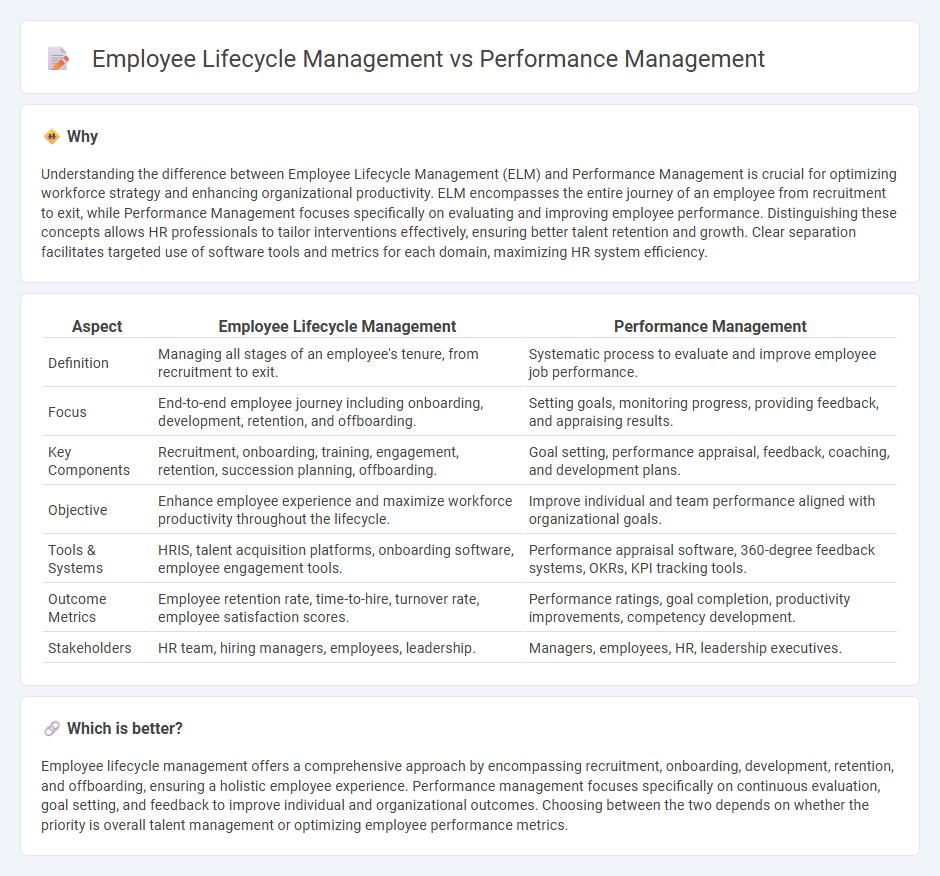
Employee lifecycle management encompasses the comprehensive stages of an employee's tenure from recruitment, onboarding, development, retention, to separation, focusing on optimizing workforce efficiency and satisfaction throughout each phase. Performance management specifically targets continuous assessment, feedback, and enhancement of employee productivity and goal alignment with organizational objectives. Explore deeper insights into how both approaches interact to drive strategic human resource success.
Why it is important
Understanding the difference between Employee Lifecycle Management (ELM) and Performance Management is crucial for optimizing workforce strategy and enhancing organizational productivity. ELM encompasses the entire journey of an employee from recruitment to exit, while Performance Management focuses specifically on evaluating and improving employee performance. Distinguishing these concepts allows HR professionals to tailor interventions effectively, ensuring better talent retention and growth. Clear separation facilitates targeted use of software tools and metrics for each domain, maximizing HR system efficiency.
Comparison Table
| Aspect | Employee Lifecycle Management | Performance Management |
|---|---|---|
| Definition | Managing all stages of an employee's tenure, from recruitment to exit. | Systematic process to evaluate and improve employee job performance. |
| Focus | End-to-end employee journey including onboarding, development, retention, and offboarding. | Setting goals, monitoring progress, providing feedback, and appraising results. |
| Key Components | Recruitment, onboarding, training, engagement, retention, succession planning, offboarding. | Goal setting, performance appraisal, feedback, coaching, and development plans. |
| Objective | Enhance employee experience and maximize workforce productivity throughout the lifecycle. | Improve individual and team performance aligned with organizational goals. |
| Tools & Systems | HRIS, talent acquisition platforms, onboarding software, employee engagement tools. | Performance appraisal software, 360-degree feedback systems, OKRs, KPI tracking tools. |
| Outcome Metrics | Employee retention rate, time-to-hire, turnover rate, employee satisfaction scores. | Performance ratings, goal completion, productivity improvements, competency development. |
| Stakeholders | HR team, hiring managers, employees, leadership. | Managers, employees, HR, leadership executives. |
Which is better?
Employee lifecycle management offers a comprehensive approach by encompassing recruitment, onboarding, development, retention, and offboarding, ensuring a holistic employee experience. Performance management focuses specifically on continuous evaluation, goal setting, and feedback to improve individual and organizational outcomes. Choosing between the two depends on whether the priority is overall talent management or optimizing employee performance metrics.
Connection
Employee lifecycle management encompasses recruitment, onboarding, development, retention, and offboarding, directly influencing performance outcomes. Effective performance management provides continuous feedback and goal alignment, which enhances employee engagement and productivity throughout each lifecycle stage. Integrating these processes ensures optimized talent development and sustained organizational success.
Key Terms
**Performance Management:**
Performance management centers on setting clear goals, continuous feedback, and regular evaluations to enhance employee productivity and align individual performance with organizational objectives. It involves key processes such as goal setting, performance appraisals, coaching, and development plans that drive both short-term improvements and long-term growth. Discover more about how effective performance management strategies can transform workforce engagement and business outcomes.
Goal Setting
Performance management centers on setting clear, measurable goals aligned with organizational objectives to drive employee productivity and growth. Employee lifecycle management incorporates goal setting at various stages, from onboarding to development and retention, ensuring continuous alignment between individual aspirations and company needs. Explore how integrating goal-setting strategies enhances both performance outcomes and employee engagement throughout the lifecycle.
Feedback
Performance management centers on continuous feedback to enhance employee skills, set goals, and improve productivity through regular evaluations. Employee lifecycle management integrates feedback at various stages--including onboarding, development, and exit--to ensure a holistic approach to talent management and employee engagement. Explore how effective feedback strategies can transform both performance outcomes and employee experiences.
Source and External Links
What Is Performance Management? The Complete Guide - Performance management is an ongoing process where managers and employees regularly communicate to assess job responsibilities, set goals, and foster continuous improvement and professional growth.
What is Employee Performance Management? - Performance management uses technology and regular feedback to align employee goals with business objectives, set clear expectations, and identify training needs for ongoing development.
What is Performance Management and Why is it Important? - The performance management cycle includes planning, monitoring, developing, and rating to motivate employees, increase productivity, and support organizational growth.
 dowidth.com
dowidth.com